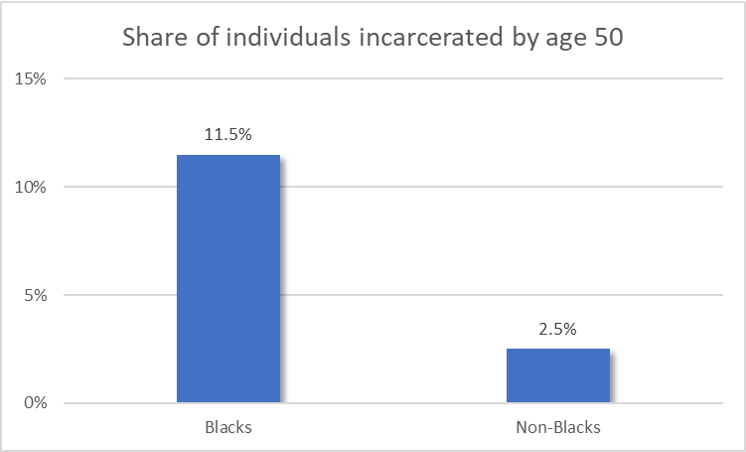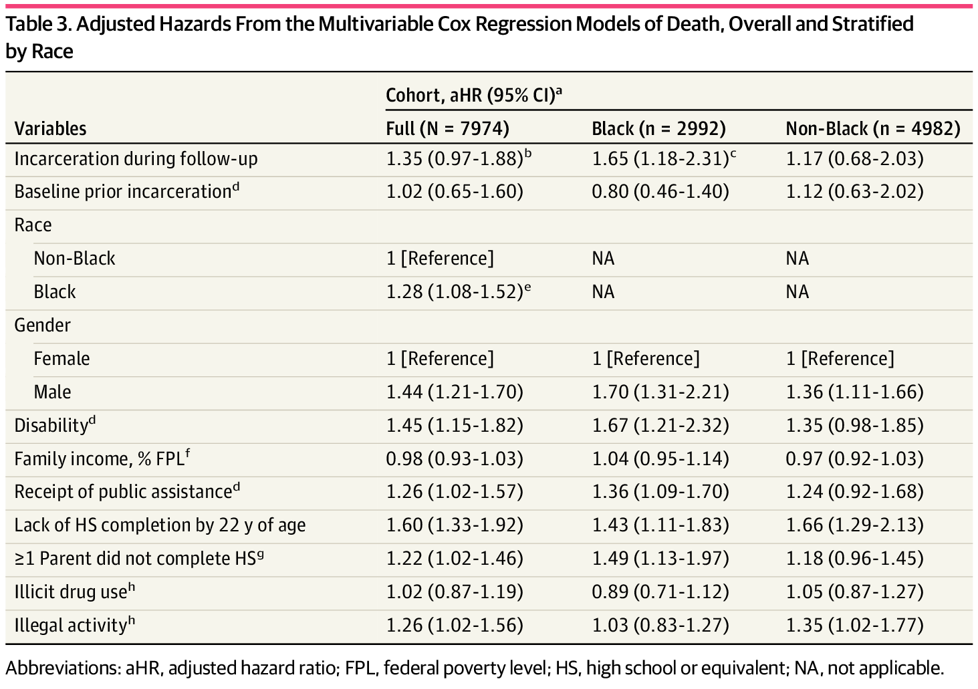According to a study Bovell-Ammon et al. (2021) in JAMA Open, the answer is ‘yes’. The authors use data from the National Longitudinal Survey of Youth (NLSY79), which tracks a nationally representative cohort of noninstitutionalized youths aged 15 to 22 years in 1979 through 2018. The authors used cumulative incidence function estimates to compare Blacks and non-Black risk of incarceration. As higher mortality could decrease the chance individuals are incarcerated, the cumulative incidence function accounts for the competing risk of death to produce unadjusted cumulative exposure to incarceration curves; differences in and tested for between-group difference by race using the Gray nonparametric test.
Unsurprising, Black individuals were much more likely to be incarcerated. Between the ages of 22 and 50 years of age, 11.5% of black were incarcerated (more than 1 in every 9 Blacks) compared to 2.5% of non-Blacks (a rate of 1 in every 40 non-Blacks).

The authors then examined whether the higher incarceration rates impacted mortality. Individuals who are incarcerated may differ than those who are not for reasons that may be correlated with both incarceration rate and mortality (e.g., sex, education, parent’s income). To address this, the authors control for the individual’s sex, parental education, receipt of government welfare assistance, and total family income. The authors then use a Cox proportional hazard model to estimate the impact of these factors and incarceration on mortality rates.
The authors found that incarceration had a significant impact on Black mortality rates but no for non-Blacks.
In the multivariable Cox proportional hazards model with the full cohort, time-varying exposure to incarceration was associated with an increased mortality rate (adjusted HR [aHR], 1.35; 95% CI, 0.97-1.88), a result that was not statistically significant. In the models stratified by race, incarceration was significantly associated with increased mortality among Black participants (aHR, 1.65; 95% CI, 1.18-2.31) but not among non-Black participants (aHR, 1.17; 95% CI, 0.68-2.03).

An editorial by Sykes et al. (2021), however, does call these findings into question. As I note above, individuals who are incarcerated may differ than those who are not incarcerated for a number of reasons. that impact both incarcerations rates and mortality. While Bovell-Ammon et al. (2021) do control for a number of observable factors (e.g., race, parent’s education, family receipt of welfare), there may still be unobservable factors that are not accounted for. Sykes and co-authors write:
For example, given that people at risk of detention and incarceration may differ in observable and unobservable characteristics, what is the counterfactual to incarceration? In the study by Ruch et al,2 youth not sentenced to detention but who were on probation (or in noncarceral treatment programs) may share more similar characteristics with youth in the juvenile justice system than nonincarcerated youth receiving Medicare. Similarly, persons convicted but not incarcerated may be more like the sample of incarcerated individuals in the NLSY79 than the nonincarcerated sample used as a comparison group in the study by Bovell-Ammon et al.
While Sykes note that selection bias could mean that mortality rates are over-estimated, other factors may indicate that the Bovell-Ammon estimates are too low. For instance,
Researchers have recently begun to investigate incarceration’s capacity to accelerate physiological and mental health decline usually associated with senescence (or aging). Accelerated aging suggests that incarcerated populations often display biological health profiles that appear older than their chronological age and experience an unusually early onset of health problems. But accelerated aging research has primarily focused on adult prisoners and needs to explore the aging consequences for incarcerated juveniles undergoing biological, mental, and social development.
Further, the Bovell-Ammon paper looks at young adults in 1979 and does not take into account the impact of the subsequent boom in the prison population–and potentially changing prison conditions–in later decades. Despite these limitations, the paper raises an important issues that merits much more investigation.